Countertop built-in sink: installation diagrams and analysis of installation features
A sink in the bathroom is a daily necessity. Not so long ago, there was simply no particular choice when buying this plumbing fixture, whereas today there are many varieties of really necessary equipment.
The sink built into the countertop is especially popular. This is because it is convenient, practical and at the same time has a very attractive appearance.
The content of the article:
Built-in sinks: what are they?
Built-in are called sinks that make up with the countertop, as it were, a single whole. By type of installation, they can be divided into two groups. The first includes so-called overhead or top-mounted appliances.
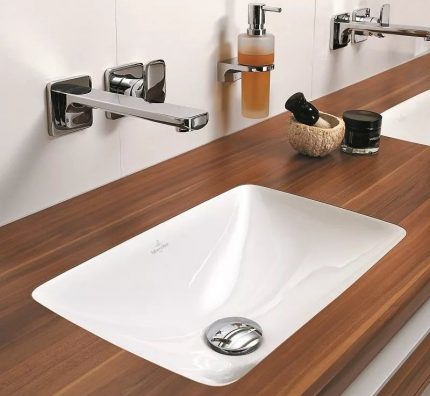
If installed incorrectly, moisture can enter the countertop through this seam, resulting in rapid destruction of the base. At the same time, overhead models are easy to install and relatively low cost.
The second group - integrable (or bottom-mounted) models - are inserted into the base and secured from the inside with special fasteners. They become a kind of continuation of the countertop. This is a more aesthetic option, however, installing it is a little more complicated, and the cost is higher.
When buying a sink mounted in the countertop for the bathroom, it is necessary to pay attention to what material it is made of, since its operational characteristics and installation method will depend on this.Consider what material is used to manufacture plumbing fixtures.
Ceramics
The material is burnt clay. You need to know that, depending on the manufacturing method, a ceramic sink can be porcelain or earthenware. The first option is more fragile.
Moreover, it is more homogeneous and dense than faience. Porcelain is easy to clean, dirt does not stick to it and it is more beautiful. Its cost is slightly higher.
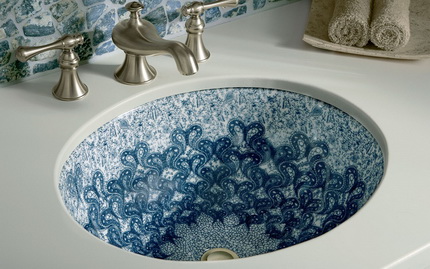
From faience produce budget models of sinks. This is a relatively inexpensive material that is more durable than porcelain. The main disadvantage of faience is the high porosity. Contaminants easily penetrate into the pores and linger in them, so it is quite difficult to care for the material.
In addition, over time, small cracks may appear on the faience, which gives it a vintage look, but affects the strength.
Metal
Stainless steel is considered the traditional material for making sinks. However, such products are usually not selected for a bathroom, unless they are selected the same with a tray in the shower or with a bathtub.
Non-ferrous metal sinks imitating copper or bronze will become more appropriate in the bathroom. Such models will fit perfectly into the Mediterranean or rustic style.

Metal sinks have many advantages. They are strong and durable, quite resistant to various mechanical damage. Their weight is relatively small, so installation is not difficult. At the same time, the products have a very attractive appearance, especially antique stylized models. The disadvantages include difficult care and high cost.
Natural and artificial stone
Of the natural materials, marble, basalt, travertine, granite or onyx are most often used. All stone sinks Very beautiful, durable and environmentally friendly. However, the cost of such products is high. This is due not only to the price of raw materials, but also to the complexity and laboriousness of the process of processing natural stone.
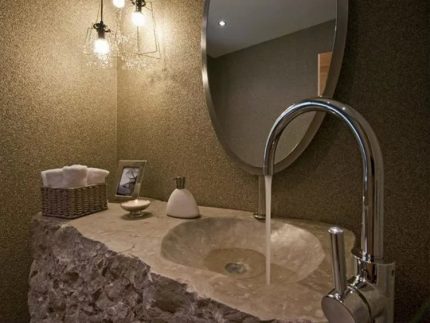
Only special products can be used to care for products; acids and abrasives can damage them.
Artificial material has all the advantages of natural and even surpasses it in strength. It consists of about 80% of stone chips, which binds a special polymer. The result is a very strong and durable product, which is also not capricious in care. Their cost is more democratic.
Glass
Products are made of special tempered glass, the strength of which is sufficient for the seamless use of such a sink. The glass surface of the equipment is resistant to mechanical damage, it is almost impossible to scratch it.
In addition, the high density of the glass prevents dirt from absorbing into the surface. Products are insensitive to temperature extremes and aggressive chemicals.

Glass sinks are externally very attractive. They can be produced in a variety of colors, transparent or tinted. The shape of the product can also be any, even the most unexpected.
Discomforts to the owner can be caused by stains and traces of water remaining on the glass, but the use of special cleaning agents can easily solve this problem.For transparent sinks, special chrome components are used.
Why choose a sink in the countertop?
A sink built into the countertop is very practical. This option for the location of the plumbing fixture has many advantages. First of all, equipped countertop or washbasin cabinet Helps to properly organize the space of the bathroom.
The curbstone in which the sink is built in can be either direct or angular. The latter option allows you to maximize the free space of the room.
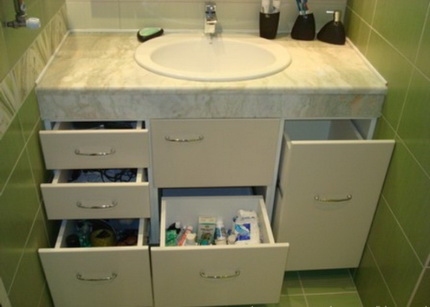
Thanks to the countertop, the “working” zone of the sink increases significantly, which allows you to store all hygiene items directly on it, without cluttering the wall with shelves.
Engineering communications are securely hidden inside the cabinet on which the countertop rests. As a result, another storage space appears in which it is convenient to keep washing powders, stain removers and any other means.
The built-in sink is more reliable than its hanging counterparts. This is explained by the fact that the bowl around the entire perimeter rests on the walls of the base, therefore, if necessary, can withstand large loads.
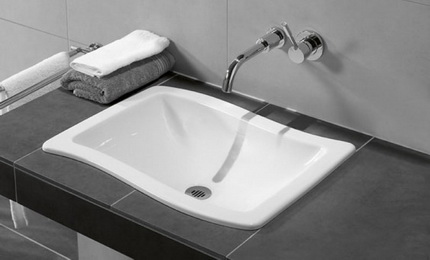
The installation method of such equipment involves greater tightness. If the device is correctly installed, when washing the water does not fall into the base and the cabinet, as well as on the floor. The latter is provided by the wide enough edges of the countertops.
Perhaps outwardly designs with a built-in sink may seem bulky. It all depends on the chosen model, area and style in which the bathroom is decorated. In any case, you should select the dimensions and design of the sink and the base, guided by the design of the room.
Features of mounting a built-in washbasin
To understand how to install a sink in the countertop, you need to decide on the installation option.
There are several ways:
- Flush with countertop. A hole is made at the base, at the edges of which small recesses are arranged, where the sides of the sink fit.
- "Recessed" sink in the base. Assumes that the top edge of the product will be slightly below the tabletop plane.
- Equipment rising above the base. In this case, the sides of the sink are laid on the edges of the holes cut out in the countertop, which serve as their support.
- Partially integrated washbasin. The device falls into the hole in the base one third, half, or otherwise. The rest of the equipment rises above the countertop.
Depending on the chosen installation method, the installation procedure will also vary, although in general everything goes approximately the same. Before work, the master needs to prepare tools and materials.
We will need a Phillips and slotted screwdrivers, building level, marker or pencil, tape measure, drill or screwdriver, screws, masking tape, silicone sealant and sandpaper. An electric jigsaw is usually used to make a hole in the countertop, but if it is made of artificial stone, you will need a grinder.
Hardware Installation Instructions
After the necessary tools and materials have been prepared, you can begin to work. It is carried out in several stages.
Choosing a sink location
It is clear that the place where the sink will be located is predetermined. But now you need to accurately identify the seat of the device. It is important to consider several key points.
The equipment can be installed almost anywhere on the countertop. It would be a mistake to assume that this can only be done exactly in the middle of the foundation.

Placing the sink close to the edge, you need to understand that the remaining section of the base should be wide enough so as not to lose strength and not break off during operation. In addition, you need to make sure that utilities can be easily connected to the sink, they should not interfere with anything.
The internal supporting elements of the cabinet must not interfere with the connections. If this is not the case, the sink should be positioned somehow differently, since damage to the supporting structure threatens to destroy the cabinet.
Note that in addition to marking the location of the bowl before starting work, you should also mark the points of attachment of the countertop to the wall, if it does not rest on a pedestal. In this case, it is marked out according to the principle of determination sink heights.
Preparation of the main template
To properly insert the sink into the base, you will need a template. This is the name of the paper part, repeating the contours of the sides of the product. Usually the template comes with a sink.
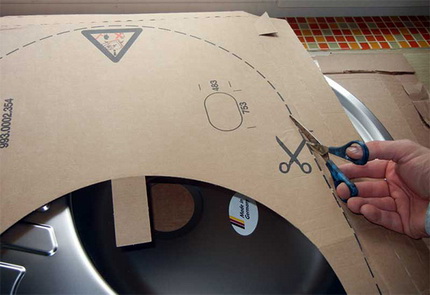
To do this, you need a sheet of cardboard of sufficient size. It is laid on a horizontal surface, after which a sink is laid upside down on it. The device is pressed to the cardboard and carefully circled along the edge of the sides. The finished template is cut with scissors and used for its intended purpose. Some people prefer not to bother with the preparation and circle the sink right on the countertop.
Marking the base for equipment
The marking procedure will vary slightly depending on the method of fixing the sink under the countertop. To get started, take the template and put it in the place where the equipment should be.
If it is assumed that the sink will rest on the edge of the hole with the sides, proceed as follows: carefully measure the size of the sides, then gently circle the template.

If the sink is to be recessed into the countertop, they act differently. In this case, the mounting hole should correspond to the dimensions of the sink so that it can sink into the base.
To fix such a product in place, special fasteners are used. To mark the so-called semi-built-in sink, a template is used that repeats the contours of the product at the level of embedding. As in the case of the “recessed” sink in the base, it is circled exactly along the contour; no allowances are necessary.
If the countertop and plumbing fixture are fixed separately, then fixing the sink to the wall produced in the standard way described in our recommended article.
Making holes for the device
In standard wood-worktops with different finishes, the hole is easiest to make with an electric jigsaw.
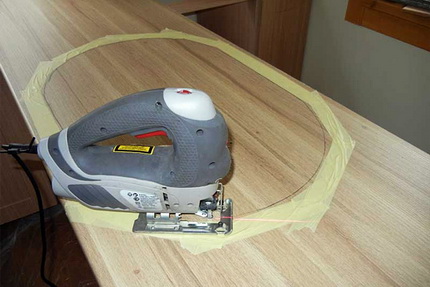
First you need to prepare a hole through which you can insert the jigsaw blade. To do this, take a drill and drill a hole in that part of the countertop, which will subsequently be removed. We insert the blade and begin to cut.
We work extremely carefully and carefully so that unwanted chips and cracks do not appear on the base. We carefully clean the walls of the finished hole with sandpaper. They must be smooth and even, chips on them are unacceptable. Now you need to protect the base section from moisture.
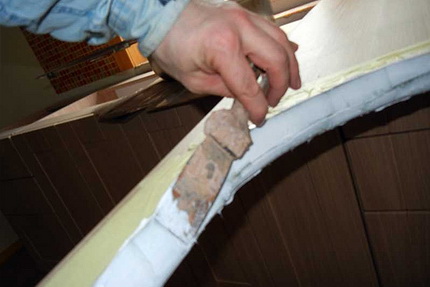
To make it more convenient to work, you can take a narrow spatula. We put a sealing tape on the sealant. It can be made of thin rubber or foamed polyethylene.
Quick step-by-step photo guide
To visualize the process of inserting a sink into a countertop, we suggest that you familiarize yourself with the photo instruction:
The following steps are to prepare the hole and the sink itself for installation. Proceed:
Now the sink in the countertop is completely ready for connection to the sewer outlet and for installing the mixer.
Engineering communications
Now it will be convenient to bring engineering communications to the sink installation site. Let's start with the sewer. If necessary, we make holes in the cabinet and start the pipe inside the structure. We equip everything as convenient as possible for the subsequent connection of the sink.
Next, we work with plumbing. We start inside the pipe for cold and hot water. The mixer is usually mounted on a countertop, if so, it is best to install it at this stage. If produced faucet installation, then it is fixed on the device before attaching to the countertop.
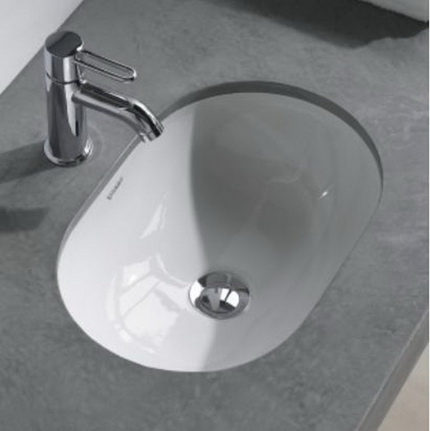
First, we assemble the mixer, guided by the assembly instructions, which a conscientious manufacturer must put in the package with the product. We fix a flexible eyeliner. On its fittings are rubber cuffs.
Experienced plumbers are advised to moisten them with water before screwing them into place. After the mixer is ready for installation, we put a special o-ring on its lower part.
Now you can cut a hole for the mixer in the countertop, then insert the device into it, passing the eyeliner into the hole. On the reverse side of the countertop, we put a clamping washer, having previously installed a special rubber gasket under it.
During operation, it will prevent possible leaks. Next, screw the nut onto the stud. We level the mixer as much as possible and tighten the fasteners.

After we have completely tightened the nuts, we check the correctness and strength of the mixer installation. It should not spin or move. The appliance must stand firmly in its intended place.
It remains to connect it to the water pipes. Flexible eyeliner nuts are screwed onto the appropriate parts. For better compaction, you can additionally use fum tape or linen.
Installing the sink on the seat
We put a sealant on the sealing tape previously glued to the cut-off of the landing hole, put it on the attachment points for the sink, if any. We bend the fasteners slightly so that they do not interfere and insert the bowl into the hole.
Swing the product slightly to choose the optimal position for it. After we find it, we tighten all the fasteners to the end and carefully remove the excess sealant that protrudes around the bowl.

If the sink is a consignment note with wide sides, be sure to coat silicone sealant under them. So it will be possible to protect the resulting seam from the damaging effects of moisture. Carefully inspect the cabinet with a sink from the inside.
All gaps and seams are carefully treated again with silicone sealant. Similarly, we act with the junction of the base and mixer.
Mounting and connecting the siphon
We start with the assembly of the product. As with the mixer, we carry it out exactly according to the manufacturer's instructions. The most important point in carrying out this procedure is compliance with the tightness of the joints.
We pay special attention to the lower plug, since it is the main fluid pressure that is responsible for it. It is advisable to carefully inspect it before buying for the presence of burrs, chips and other defects. They should not be, otherwise the integrity of the gasket will be violated.
It happens that the manufacturer supplies siphons in an already assembled form. In this case, you should not be too lazy and disassemble the device. So it will be possible to control the presence and integrity of the gaskets, as well as the fastening of all elements of the device. We collect the siphon, controlling the clamping force, so as not to accidentally damage the product.
When mounting the bottom plug and all equipment connections, it is advisable to fix the gaskets with sealant. We twist the elements of the device without strong pressure, but all the way. Having replaced the exhaust pipe, tighten the fixing screw, and then remove the excess sealant with a damp cloth.
Experienced craftsmen remind you that the height of the siphon can be adjusted due to the outlet pipe. We fix the siphon on the sink and screw the part with the trap. Then we connect the main part of the equipment to the sewer pipe.
If the design of the sink is designed for overflow installation, connect two nozzles to the bowl. We recommend that you familiarize yourself with the walkthrough described in our article.
After this, it is advisable to conduct a test run, even if it is planned to connect additional equipment to the same pipe. For example, if mounted siphon for connecting washers to the sewer outlet common with the sink.
So it will be easier to deal with possible problems. At the time of the test run, we close the additional holes with special plugs. We open the water supply, check the operation of the siphon. If everything is in order, turn off the water and, if necessary, connect additional equipment.
Plumbers recommend additionally securing the drain hose from the washing machine with a hose clamp so that it is not torn off by water.The hose extending from the siphon should not be stretched or kinked so that the outflow of fluid is not complicated by anything.
Recommendations from experienced plumbers
And in conclusion, a few recommendations from professionals on how to properly attach the sink to the countertop. The first concerns sawing holes in the base. At this stage, it is important not to damage the base and make a seat of the right size.

If there is no sealant, then for processing a slice of the base, you can use ordinary PVA glue. It will give the same effect. In the countertop made of artificial stone, you can cut the necessary hole using a grinder, in which a diamond-coated disk is installed.
After installing the equipment, it is worth checking the horizontal using the building level. The error will lead to unpleasant consequences.
Introduces the rules and technology for installing the sink on the countertop next articlewhich provides selection guidelines and installation instructions.
Conclusions and useful video on the topic
Video # 1. Subtleties of installation of the built-in sink:
Video # 2. A detailed story about installing a built-in sink:
Video # 3. What type of sink is better to choose for installation paired with a countertop:
A sink built into the countertop is a practical and beautiful solution for any bathroom. It will be appropriate both in a spacious and in a small room.
In addition to its attractive appearance, such a sink is very convenient to use, so it enjoys special demand among designers, and its popularity continues to grow. Installation of built-in equipment is simple and accessible even to a novice master.
Tell us about how to assemble and connect built-in plumbing with your own hands. It is possible that in your arsenal there are technological subtleties that are useful to site visitors. Please write comments, post photos on the topic of the article, ask questions in the block below.

 Countertop washbasin: features of selection and installation
Countertop washbasin: features of selection and installation 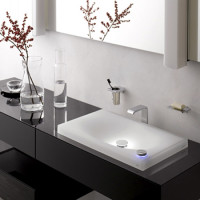 Overhead sink on the countertop in the bathroom: how to choose + installation manual
Overhead sink on the countertop in the bathroom: how to choose + installation manual 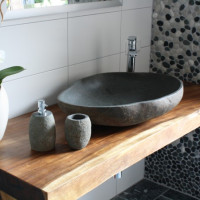 Stone sink: advantages and disadvantages of natural stone, comparison with alternative options, installation nuances
Stone sink: advantages and disadvantages of natural stone, comparison with alternative options, installation nuances 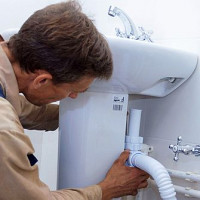 Bathroom sink with pedestal: installation and connection technology
Bathroom sink with pedestal: installation and connection technology 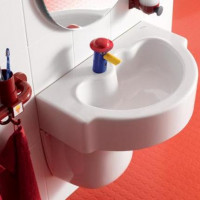 Bathroom sink height: standards and best wiring diagrams
Bathroom sink height: standards and best wiring diagrams 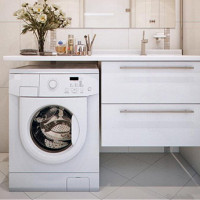 Hanging cabinet with sink: selection tips + analysis of installation technology
Hanging cabinet with sink: selection tips + analysis of installation technology  How much does it cost to connect gas to a private house: the price of organizing gas supply
How much does it cost to connect gas to a private house: the price of organizing gas supply  The best washing machines with dryer: model rating and customer tips
The best washing machines with dryer: model rating and customer tips  What is the color temperature of light and the nuances of choosing the temperature of the lamps to suit your needs
What is the color temperature of light and the nuances of choosing the temperature of the lamps to suit your needs  Replacement of a geyser in an apartment: replacement paperwork + basic norms and requirements
Replacement of a geyser in an apartment: replacement paperwork + basic norms and requirements
Installing such a sink is no more difficult than a conventional one. Connection to the siphon according to the standard scheme. But how am I tormented to fit her under the hole in the countertop. It seems to have calculated everything, but water still flowed. Remade several times, to no avail. As a result, just from below, under the countertop, I fixed all around the perimeter with mounting foam. Now does not leak.